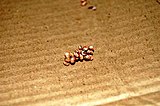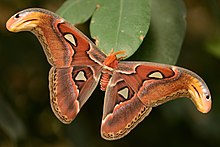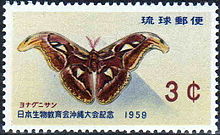Attacus atlas
| Atlas moth | |
|---|---|

| |
| Female with reduced antennae | |
| Scientific classification | |
| Domain: | Eukaryota |
| Kingdom: | Animalia |
| Phylum: | Arthropoda |
| Class: | Insecta |
| Order: | Lepidoptera |
| Family: | Saturniidae |
| Genus: | Attacus |
| Species: | A. atlas
|
| Binomial name | |
| Attacus atlas | |
Attacus atlas, the Atlas moth, is a large saturniid moth endemic to the forests of Asia. The species was described by Carl Linnaeus in his 1758 10th edition of Systema Naturae.
The Atlas moth is one of the largest
Description
| Holometabolism (complete metamorphosis) | ||||
|---|---|---|---|---|

|

|

|

|

|
| Eggs | Larva (3rd instar) | Pupa within cocoon | Emerging from pupa | Imago |
Eggs
Atlas moths lay a number of spherical eggs, 2.5 mm (0.098 in) in diameter, on the undersides of the leaves of food plants.
Larva
After approximately two weeks, dusty-green caterpillars hatch and feed on their egg-shell, and then the foliage of citrus, cinnamon, guava, and evergreen trees.[6] The caterpillars can grow to 11.5 cm (4.5 in) in length and 2.5 cm (0.98 in) in thickness. They have white, waxy, fleshy spines along their backs, which become more prominent at later instars. On the last abdominal segment beside the prolegs, there is a large green spot surrounded by an orange ring.[7]
Pupa
After reaching a length of about 11.5 cm (4.5 in), the caterpillars

Imago

Adult Atlas moths are weak, unsteady fliers. To conserve energy, the moths rest during the day and fly at night. As they lack fully formed mouthparts, the adults cannot eat, subsisting entirely on fat reserves accumulated during the larval stage. As a result, they live for only a few days during which their sole objective is seeking out a mate. Adults may be found on wing throughout the year but are most abundant between November and January.
Females release
The body is small compared to the wings. The upper side of the wings are reddish brown with a pattern of black, white, pink, and purple lines. There are triangular, scale-less windows bordered in black on each of the four wings. The undersides of the wings are paler. The tips of both forewings have prominent extensions that resemble the head of a snake. The resemblance which is exaggerated by movements of the wings when the moth is confronted by potential predators.[9]

The Atlas moth has a very short, vestigial proboscis, and they do not eat once they have emerged from the cocoon, relying on fat storage for energy. Every flight takes valuable energy and can take days off their already short lives, as it has a very short life span of only one to two weeks.[10] They conserve energy by flying as little as possible. A female will wait for a male to come along and be fertilised, lay eggs and die.
Habitat

Their
Etymology
Atlas moths are named after Atlas, the Titan of Greek mythology (due to their size). In Hong Kong, the Cantonese means "snake's head moth", referring to the prominent extension of the forewing that resembles the head of a snake.[12][citation needed]
Relationship with humans

In
The Japanese subspecies A. a. ryukyuensis, native to Yonaguni in the Yaeyama Islands.
Similar taxa
The term "Atlas moth" is sometimes used mistakenly as a name for any species in the genus
See also
References
- ^ a b "Chapter 32: Largest Lepidopteran Wing Span | The University of Florida Book of Insect Records | Department of Entomology & Nematology | UF/IFAS". entnemdept.ifas.ufl.edu.
- ^ "StackPath". australianbutterflies.com. 26 October 2018.
- ISBN 0-907408-62-1
- ISBN 978-1-405-15142-9
- ISBN 3-540-30146-1
- ISBN 983-40053-3-4
- ^ Gosse, Philip Henry (1879). "The great Atlas moth of Asia (Attacus atlas, Linn.)". West, Newman & Company – via Gale Primary Sources.
- ^ Shepherd, G.M. (1994). "Chemical Senses". In Neurobiology 3rd Edition. Oxford University Press
- ISBN 978-1901092806
- ^ "Spotlight: the atlas moth". www.nhm.ac.uk. Retrieved 2019-08-21.
- ^ Holloway, J.D. (1987). The Moths of Borneo, part 3: Lasiocampidae, Eupteroptidae, Bombycidae, Brahmaeidae, Saturniidae, Sphingidae. Southdene Sdn. Bhd., Kuala Lumpur
- ISBN 988-97173-9-5
- ^ Jolly, M.S., Sen, S.K., Sonwalkar, T.N. & Prasad, G.S. (1979). Non-mulberry silks. Food & Agriculture Organisation. United Nations, Serv. Bull. 29. Rome. xvii + 178pp
- S2CID 9466921 – via Science Citation Index.)
{{cite journal}}: CS1 maint: multiple names: authors list (link - ^ Moore, Frederic (1880). The Lepidoptera of Ceylon. Vol. II. London: L. Reeve & co. pp. 124–125.
- ISBN 0961146427. Retrieved 5 June 2018.
- ^ Savela, Markku. "Attacus atlas (Linnaeus, 1758)". Lepidoptera and Some Other Life Forms. Retrieved November 10, 2018.
